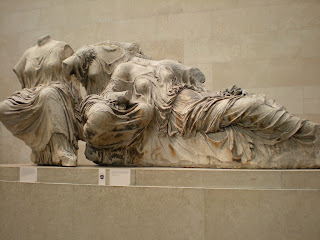 The British Museum is a magnificent structure whose current edifice was erected in the 19th century (“British”). The museum houses artifacts from a variety of time periods, contains a number of artwork galleries, and its treasures come from all over the world.
The British Museum is a magnificent structure whose current edifice was erected in the 19th century (“British”). The museum houses artifacts from a variety of time periods, contains a number of artwork galleries, and its treasures come from all over the world.The museum’s collection dates back to 1753 when the British government bought the 80,000 piece collection of plants, fossils, coins, medals, and prints from British doctor Sir Hans Sloane (“British”). Today’s museum now boasts to have the largest museum collection in the world (“British”). The exhibit in the British Museum that peaked my interest the most was that of the remains from the Athenian Parthenon.

After studying ancient Grecian architecture in my Humanities class last year, I was awed and amazed by the magnificent detail that is still in tact on the huge portions of the Parthenon that I had only seen in books and learned about in lectures. Seeing these works of genius in real life changed my perspective on ancient Greece because I could see their handiwork for myself, and I could physically observe the representations of their traditions that lasted for centuries, and continue to fascinate many today.
The acquisition of such large, beautiful pieces of history is an interesting story. The Parthenon was the biggest draw for Western visitors to Athens (St. Clair, 47). The Earl of Elgin was a British Ambassador to the Ottoman Court in the 19th century (Cook, 4). At the time in which the Elgin marbles were purchased by the British government, sculpture was the least flourishing medium of art in England (St. Clair, 245). While he was serving as an ambassador Elgin had collected a fantastic collection of “marbles” – sculptures, architectural fragments and inscriptions from the Parthenon (Cook, 4). In August 1800 Lord Elgin and his artists came to Athens with the goal to “improve the arts in great Britain” (St. Clair, 43). This extraordinary collection is known today as the Elgin Marbles. Elgin convinced the House of Commons to purchase this large collection in the early 19th century (Cook, 4). Lord Duveen in 1962 commissioned the building of an exhibition gallery in the British Museum specifically for the collection’s sculptures from the Parthenon (Cook, 4).
The Parthenon is dedicated to the Greek goddess Athena, and it was built between 447 and 438 B.C. on the top of the Acropolis (Cook, 5). It is world-renowned for its magnificent symmetry, designs, and outward-showing of respect for the Greek gods.
Pericles, a statesman in Athens during time of the Parthenon’s re-construction, oversaw a huge building effort during his reign, including many of the Acropolis’ structures (Cook, 10). The pediments, metopes and friezes are the forms of marble sculptures on the temple, and as Plutarch observed, “the most amazing feature of the Periclean building programme was the speed with which the actual buildings were completed (Cook, 14).
 In 490 BC as well as 480 BC Greece’s city states on the mainland were invaded by the armies of Darius and Xerxes, of the Persian empire (St. Clair, 47). It was not until 480 BC, however, that the Athenians were forced to leave their city and therefore, the Acropolis was occupied, burned and desecrated by the Persian armies (St. Clair, 47). Pericles oversaw the rebuilding efforts, which included taking the marble of the older temples in Athens to rebuild the walls surrounding the Acropolis, whereas the buildings inside were completely redone (St. Clair, 47).
In 490 BC as well as 480 BC Greece’s city states on the mainland were invaded by the armies of Darius and Xerxes, of the Persian empire (St. Clair, 47). It was not until 480 BC, however, that the Athenians were forced to leave their city and therefore, the Acropolis was occupied, burned and desecrated by the Persian armies (St. Clair, 47). Pericles oversaw the rebuilding efforts, which included taking the marble of the older temples in Athens to rebuild the walls surrounding the Acropolis, whereas the buildings inside were completely redone (St. Clair, 47).Works Cited
"British Museum." AboutBritain.com. 2008. AboutBritain.com. 05 May 2008
Cook, B.F. The Elgin Marbles. London: British Museum Publications, 1984.
St. Clair, William. Lord Elgin and the Marbles. Oxford : Oxford University Press, 1983.


No comments:
Post a Comment